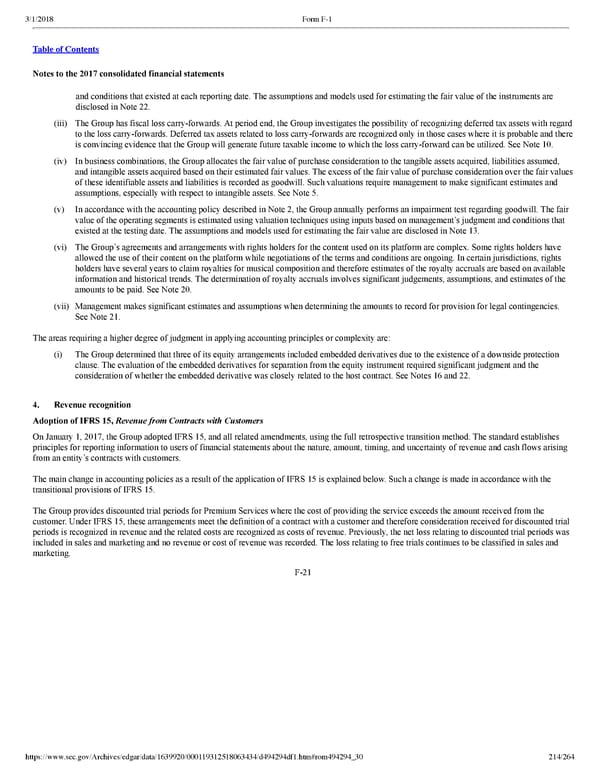214/264 Notes to the 2017 consolidated financial statements and conditions that existed at each reporting date. The assumptions and models used for estimating the fair value of the instruments are disclosed in Note 22. (iii) The Group has fiscal loss carryforwards. At period end, the Group investigates the possibility of recognizing deferred tax assets with regard to the loss carryforwards. Deferred tax assets related to loss carryforwards are recognized only in those cases where it is probable and there is convincing evidence that the Group will generate future taxable income to which the loss carryforward can be utilized. See Note 10. (iv) In business combinations, the Group allocates the fair value of purchase consideration to the tangible assets acquired, liabilities assumed, and intangible assets acquired based on their estimated fair values. The excess of the fair value of purchase consideration over the fair values of these identifiable assets and liabilities is recorded as goodwill. Such valuations require management to make significant estimates and assumptions, especially with respect to intangible assets. See Note 5. (v) In accordance with the accounting policy described in Note 2, the Group annually performs an impairment test regarding goodwill. The fair value of the operating segments is estimated using valuation techniques using inputs based on management’s judgment and conditions that existed at the testing date. The assumptions and models used for estimating the fair value are disclosed in Note 13. (vi) The Group’s agreements and arrangements with rights holders for the content used on its platform are complex. Some rights holders have allowed the use of their content on the platform while negotiations of the terms and conditions are ongoing. In certain jurisdictions, rights holders have several years to claim royalties for musical composition and therefore estimates of the royalty accruals are based on available information and historical trends. The determination of royalty accruals involves significant judgements, assumptions, and estimates of the amounts to be paid. See Note 20. (vii) Management makes significant estimates and assumptions when determining the amounts to record for provision for legal contingencies. See Note 21. The areas requiring a higher degree of judgment in applying accounting principles or complexity are: (i) The Group determined that three of its equity arrangements included embedded derivatives due to the existence of a downside protection clause. The evaluation of the embedded derivatives for separation from the equity instrument required significant judgment and the consideration of whether the embedded derivative was closely related to the host contract. See Notes 16 and 22. 4. Revenue recognition Adoption of IFRS 15, Revenue from Contracts with Customers On January 1, 2017, the Group adopted IFRS 15, and all related amendments, using the full retrospective transition method. The standard establishes principles for reporting information to users of financial statements about the nature, amount, timing, and uncertainty of revenue and cash flows arising from an entity’s contracts with customers. The main change in accounting policies as a result of the application of IFRS 15 is explained below. Such a change is made in accordance with the transitional provisions of IFRS 15. The Group provides discounted trial periods for Premium Services where the cost of providing the service exceeds the amount received from the customer. Under IFRS 15, these arrangements meet the definition of a contract with a customer and therefore consideration received for discounted trial periods is recognized in revenue and the related costs are recognized as costs of revenue. Previously, the net loss relating to discounted trial periods was included in sales and marketing and no revenue or cost of revenue was recorded. The loss relating to free trials continues to be classified in sales and marketing. F21
 Spotify F1 | Interactive Prospectus Page 213 Page 215
Spotify F1 | Interactive Prospectus Page 213 Page 215